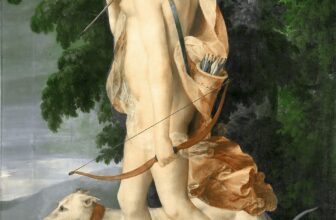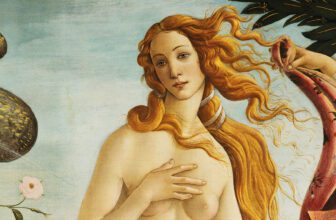A Myth of Beauty, Transgression, and Vengeance
A Glimpse into the Forbidden: The Power of Myth and Art
In the realm of classical mythology, few stories are as haunting and enigmatic as that of Diana and Actaeon. A tale of beauty, punishment, and the fragile line between innocence and offense, this myth has resonated through centuries, captivating poets, playwrights, and painters alike. Among those who dared to bring this story to life on canvas was one of the most revered masters of the Renaissance: Titian, also known as Tiziano Vecellio.
The story of Diana and Actaeon is not just an ancient myth; it is a parable of consequence, desire, and the sanctity of privacy. It captures a fleeting moment, an accidental trespass, that spirals into tragedy. And in Titian’s hands, that moment becomes immortal.
Let us journey through the myth, unravel its meaning, and explore the masterpiece that continues to captivate art lovers around the world.
Who Painted Diana and Actaeon?
The iconic painting Diana and Actaeon was created by the Venetian master Titian, one of the greatest painters of the Italian Renaissance. Born around 1488–1490 in Pieve di Cadore, Titian rose to prominence in Venice and became renowned for his masterful use of color, composition, and his ability to capture the emotional depth of mythological and religious subjects.
Diana and Actaeon was commissioned by King Philip II of Spain in the mid-16th century as part of a series of mythological works inspired by the Roman poet Ovid’s Metamorphoses. These paintings, often referred to as poesie (poems), were visual interpretations of classical stories, intended to be seen not only as art but as visual poetry.
Completed around 1556–1559, Diana and Actaeon is one of Titian’s most celebrated mythological works, paired with its dramatic companion, Diana and Callisto. Together, they form part of a cycle that includes Venus and Adonis, Perseus and Andromeda, The Rape of Europa, and others.
The Story of Diana and Actaeon
The myth of Diana and Actaeon originates in Book III of Ovid’s Metamorphoses, a poetic masterpiece from ancient Rome that has provided endless inspiration for Western art and literature.
Actaeon was a skilled hunter, the grandson of Cadmus and a prince of Thebes. One day, while roaming the forests with his hunting dogs, he wandered away from his companions and stumbled upon a secluded grove. There, he encountered a hidden cave fed by a cool spring, sacred ground where Diana, the chaste goddess of the hunt (known as Artemis in Greek mythology), bathed in secret with her nymphs.
To the goddess’s horror, Actaeon gazed upon her nude form, an unforgivable offense, not because of lust, but because it was a transgression against the divine sanctity of her privacy and purity.
What Does Diana Throw at Actaeon When He Sees Her?
In Titian’s painting and in Ovid’s text, this crucial moment is captured with riveting drama. Diana, startled and enraged by the intrusion, reacts swiftly. According to the myth, she splashes water at Actaeon’s face, a simple act, yet one imbued with magical consequence.
This splash is no ordinary retaliation; it carries with it a divine curse. As the droplets hit his face, Actaeon begins to transform. His human form disappears, replaced by the antlered head and furry body of a stag. Silenced, unable to cry out or defend himself, he flees into the woods in confusion and terror.
Why Did Diana Punish Actaeon?
Diana’s punishment of Actaeon may seem harsh to the modern mind. After all, his transgression was accidental, he did not mean to see her. But within the context of classical mythology, the story serves as a powerful allegory on the boundaries between mortals and gods, the consequences of violating sacred spaces, and the unforgiving nature of divine justice.
In Ovid’s telling, Diana does not offer a warning or show mercy. Her virginity and modesty were inviolate. To be seen naked was to have that sanctity desecrated. By punishing Actaeon so severely, she reaffirmed the divine law of retribution, even accidental violations of sacred domains demanded swift, irreversible punishment.
The tragedy deepens when Actaeon, now a stag, becomes the victim of his own loyal hunting dogs. Failing to recognize their master, they pursue and tear him apart, completing the cycle of irony and fate. The hunter becomes the hunted, and Diana’s justice is complete.
Titian’s Interpretation: A Masterpiece of Sensuality and Tragedy
In Titian’s Diana and Actaeon, the artist captures the exact moment when Actaeon bursts into the hidden chamber of the goddess. The scene is dramatic and lush, with cascading fabrics, vibrant colors, and an exquisitely painted backdrop of classical architecture and flowing waters.
Diana stands at the center, her form commanding yet vulnerable, flanked by her nymphs. Her arm is outstretched toward Actaeon, her expression a mix of shock, anger, and divine authority. The water basin sits before her, the soon-to-be weapon of transformation.
Actaeon, on the other hand, is caught mid-step. His expression reflects confusion and dawning realization. The scene is not yet violent, but the tension is palpable. The tragedy to come is only hinted at, a masterful example of how Titian uses a single moment to suggest an entire narrative arc.
The composition balances sensuality with restraint. The nude figures are idealized yet natural, reminiscent of classical sculptures. But the painting is not merely erotic, it is emotional, psychological, and allegorical.
What is the Meaning Behind the Painting Diana and Actaeon?
Titian’s painting operates on multiple levels of meaning:
Violation of Boundaries: At its core, the story, and the painting, represents the idea that boundaries, especially sacred or divine ones, must not be crossed. Even innocent mistakes can have catastrophic consequences in a world governed by absolute divine laws.
Power and Vulnerability: Diana, though powerful, is depicted in a moment of unexpected vulnerability. Actaeon, though a noble hunter, becomes powerless. This reversal of roles is a meditation on the fluid nature of power, justice, and fate.
Transformation and Identity: Actaeon’s metamorphosis into a stag speaks to deeper themes of identity, speechlessness, and alienation. Once human, he becomes unrecognizable, even to those who loved him.
Sensuality vs. Sanctity: The painting straddles the line between eroticism and sacredness. Titian’s nudes are beautiful, but they are not meant to titillate. They evoke the tension between bodily beauty and divine prohibition.
Mortality and the Gods: The gods in mythology often act with impunity, while mortals suffer the consequences. This painting captures that cosmic imbalance, a reminder of the fragility of human life in the face of divine whims.
Where is Diana and Actaeon Located Today?
After centuries of admiration, Titian’s Diana and Actaeon has found a secure home in the public domain. In 2009, the painting was jointly acquired by the National Gallery in London and the National Galleries of Scotland in Edinburgh for £50 million, ensuring that it would remain accessible to the public rather than fall into private hands.
Today, the painting alternates between the National Gallery in London and the Scottish National Gallery in Edinburgh, depending on curatorial rotation and special exhibitions.
Its twin painting, Diana and Callisto, was also later purchased by the same institutions, completing the pair and preserving a crucial part of the Renaissance artistic heritage.
Legacy of the Myth and the Masterpiece
The myth of Diana and Actaeon has been retold in countless forms, through poetry, opera, ballet, and film. Each retelling wrestles with the same themes of justice, transgression, and transformation. But Titian’s rendering stands out as one of the most enduring and emotionally rich visual interpretations.
What makes Diana and Actaeon so powerful is not just the beauty of its composition, but the timelessness of its message. In a world where privacy, consent, and power dynamics are more relevant than ever, the story resonates deeply.
Titian’s brush captures a divine moment, a moment when fate was sealed not by malice, but by the simple act of looking.
The Eternal Moment of Diana and Actaeon
The tale of Diana and Actaeon is not a simple morality story. It is layered, ambiguous, and emotionally charged. It is about what we see, what we are allowed to see, and what the consequences of seeing might be.
Titian’s painting brings this story to life not with judgment, but with empathy and awe. It invites the viewer not just to witness, but to feel, to stand beside Actaeon at the moment of discovery and to glimpse, for a breathless instant, the divine and the doomed.
Over 450 years later, this masterpiece still compels us to ask questions: What is the cost of curiosity? How do we navigate the sacred and the profane? And most hauntingly, what happens when we see something we were never meant to see?




